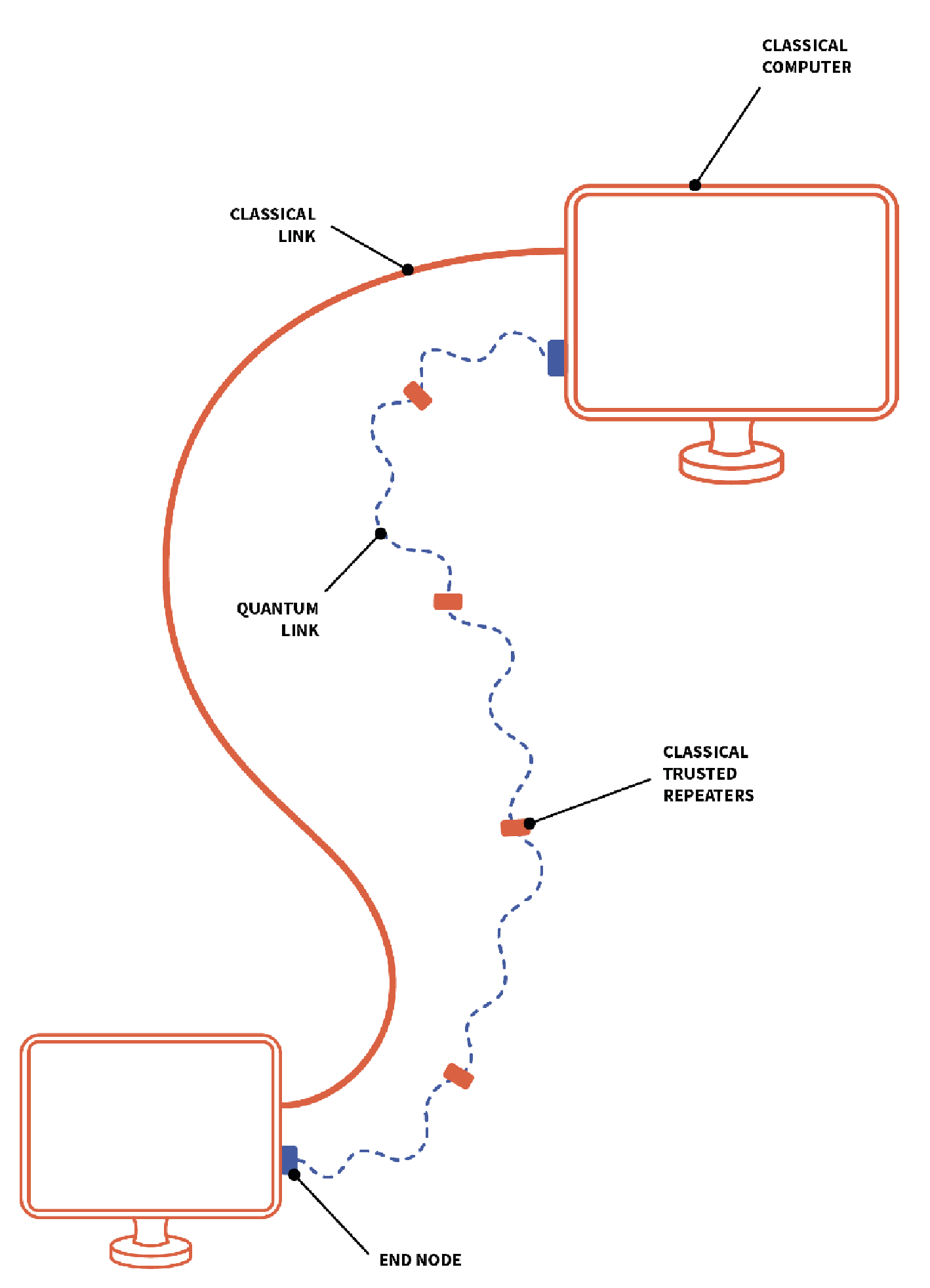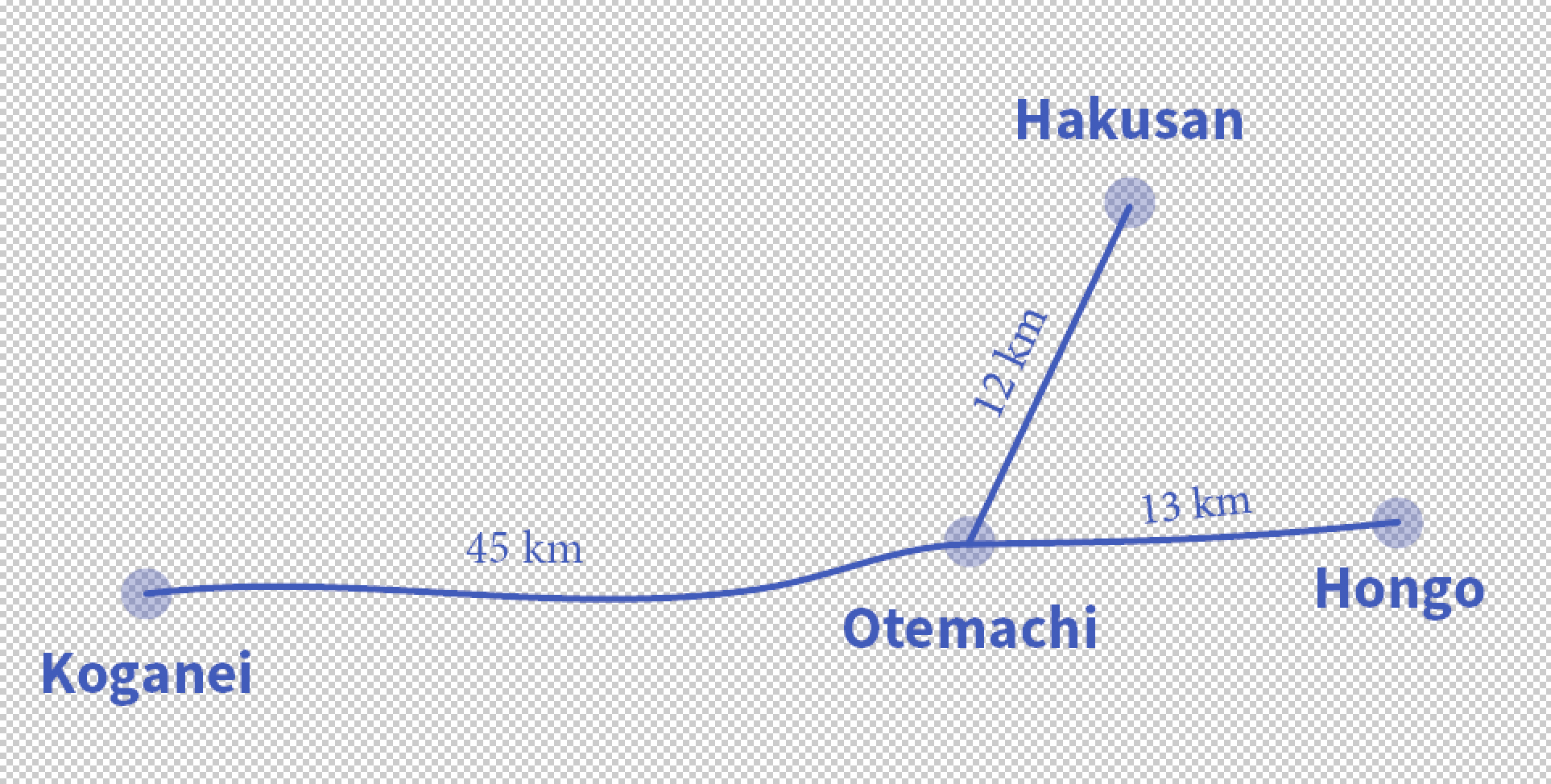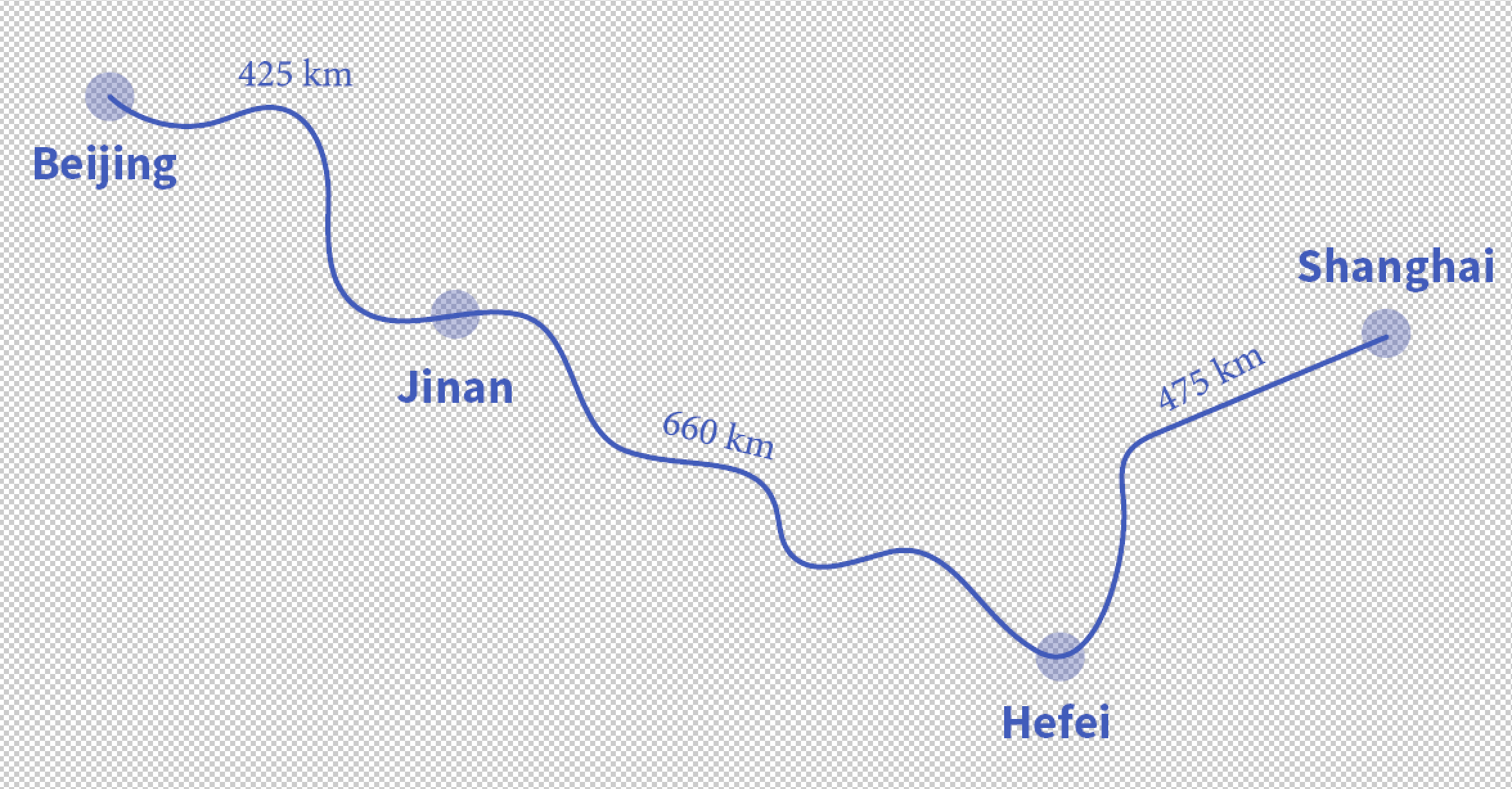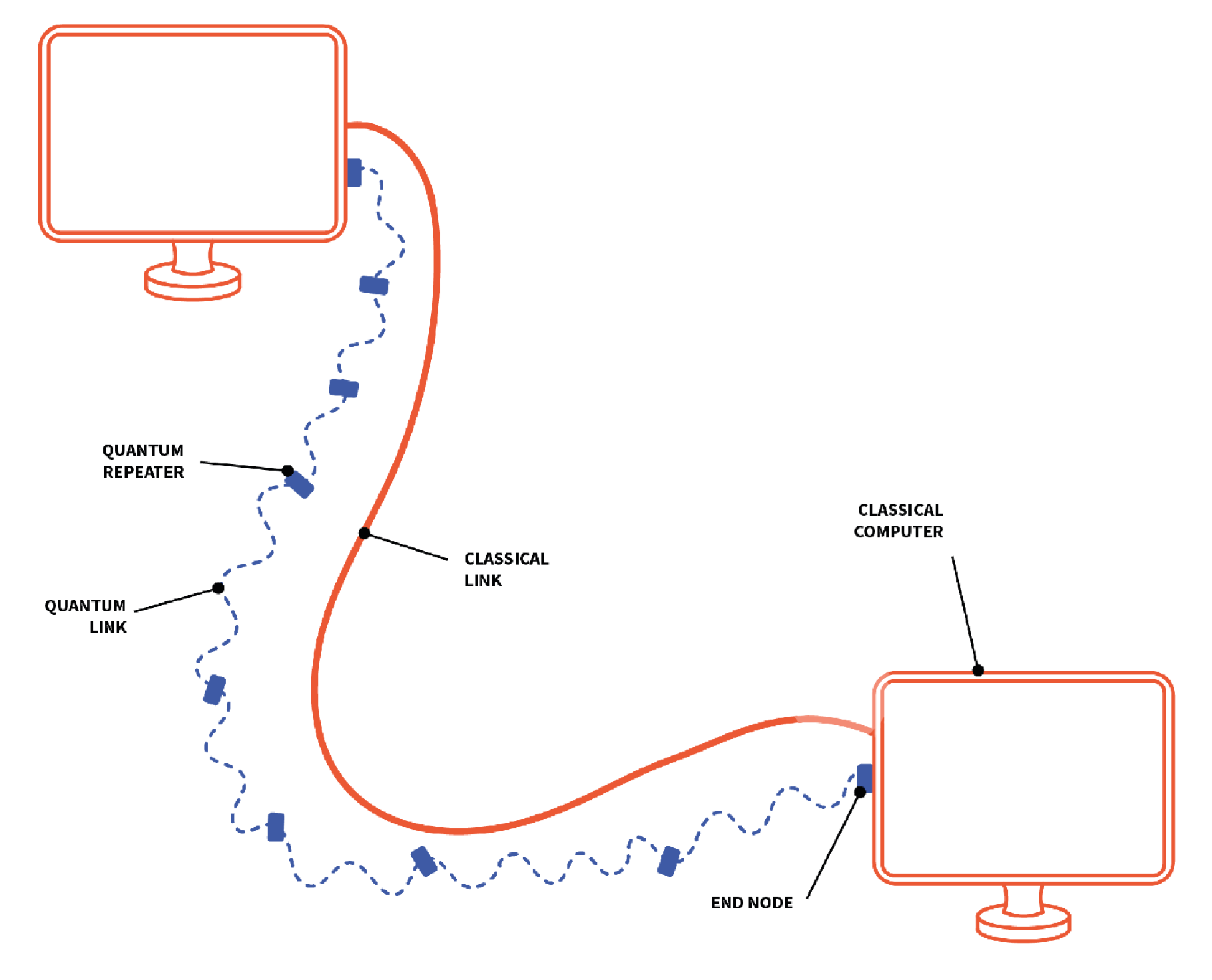The six stages of Quantum networks
Quantum networks will go through different stages of development until they reach their full functionality. Recently, researchers from QuTech proposed a roadmap towards a full quantum internet, detailing six stages of development that are determined by the functionality available to the end nodes in the network.
Stage 0
Pre-quantum networks
The initial stage is that of trusted repeater networks. In these networks, end nodes that are directly connected can perform quantum key distribution, and end nodes that are connected by a chain of intermediate repeaters can also establish a secure key, provided that the intermediate repeaters are trusted. This stage can be regarded as a pre-quantum network, or zeroth stage, since no quantum information is exchanged between end nodes.
Stages 1 and 2
Proto-quantum networks
The first truly quantum stage, prepare and measure networks, makes the end-to-end delivery of qubits possible. This allows for instance to perform quantum key distribution between any two end nodes or secure login (see pages 17 and 34-35).
The second stage, entanglement distribution networks, allows for the distribution of entanglement between arbitrary nodes in the network. In this stage it becomes possible to implement the device independent version of quantum key distribution, based on entanglement (see page 17).
The first and second stages can be seen as stages of a proto-quantum networks since they make the first applications for quantum internet available. The next three stages enable further applications and are therefore advanced quantum networks.
Stages 3, 4 and 5
Advanced quantum networks
The third stage, memory networks, requires nodes to be able to keep quantum infor-mation in a quantum memory for a certain amount of time. At this stage, teleportation (page 25) and blind quantum computation (page 27) become possible, provided that a remote quantum computer is connected to the quantum network. In this stage, the implementation of quantum clock synchronization protocols, extending the baseline of telescopes, and quantum anonymous transmission (pages 36-37) also become possible.
To reach the fourth stage, fault-tolerant few-qubit networks, local operations and memory lifetimes need to be so good that a networked or distributed quantum computer (pages 36-37) can be implemented by connecting nodes from the network.
In the fifth and final stage, quantum computing networks, a full-fledged quantum computer is situated at each of the end nodes. In this stage, all quantum applications that we currently envision can be executed. For instance, this stage is necessary to implement quantum voting protocols.
Pre-quantum network
Several pre-quantum networks are already in operation. Their quantum link is established through classical nodes, referred to as classical trusted repeaters, that are installed along the line. This setup is necessary, because quantum signals get lost when travelling through optical fibers. Typically, the classical nodes ‘refresh’ the signal at least every 100 kilometers.
Notably, Japan and China have implemented pre-quantum networks and quantum key distribution has already been performed there. This quantum key distribution, however, is not optimally secure because the classical nodes also learn the key while refreshing the signal, and need to be trusted.

Quantum network in Japan
In Japan, an operation centre in Otemachi is connected with three other places that are situated 12, 13 and 45 km away. In 2010, a secure TV conference was demonstrated between Kogenei and Otemachi by performing trusted quantum key distribution.

Quantum network in China
In China, one trusted repeater network already covers a long distance: 2000 kilometre of optical fibre connects Beijing with Shanghai. This network is being tested for banking and commercial communications, such as linking up data centres or online shopping businesses.

Proto-quantum network
Instead of classical nodes, a proto-quantum network has quantum nodes (quantum repeaters - the blue blocks in the illustration) installed along the line. Such a network allows for direct communication between two parties; this is not possible in the pre-quantum network. Quantum key distribution enables completely secure communication, since quantum nodes – unlike classical nodes – do not learn the key while refreshing the signal.

A quantum network with direct communication between the end nodes (end-to-end entanglement) is called an entanglement distribution network. In 2015, an entanglement distribution network covering a short distance was demonstrated in Delft. The two end nodes at positions A and B were placed 1.28 km apart. Entanglement between the end-nodes A and B was provided through position C.
An entanglement distribution quantum network enables the implementation of several tasks. Notably quantum key distribution, but also more mundane ones such as coordinated strategies to win online games.

Advanced quantum network
The quantum nodes in advanced quantum networks are superior in functionality to those in proto-quantum networks. A lot more applications are therefore possible with such networks. The most advanced quantum network, shown in this picture, is one in which the end nodes are replaced with quantum computers.

QuTech is working on realising an advanced quantum network in the Netherlands with quantum nodes placed at Delft, The Hague, Leiden and Amsterdam. These quantum nodes will function as end nodes as well as quantum repeaters; they therefore need three properties. First, a quantum node should have a quantum memory that can robustly store qubit states. Second, it should be possible to process quantum information with high fidelity within a quantum node. Third, the quantum nodes should be able to communicate via fibres that are currently used for our classical internet.

-
A quantum internet needs a memory to store the states of qubits. Such a quantum memory can be compared to the short-term memory that a classical computer uses to speed up the access to a program, the cache memory.
Without a quantum memory, a large quantum network would not be possible. Many protocols require memories and all network links would have to be established nearly simultaneously, which is very unlikely in larger networks. Any failure would mean that all quantum superpositions are lost and need to be re-created from the start. A quantum memory allows for the network to be established step by step, while storing the precious quantum states. This enables, for example, reliably sending quantum states by quantum teleportation.
How long a quantum memory should be able to store a qubit state depends on the time it takes for the communication to succeed in the rest of the network. A couple of seconds to a minute will probably be enough. While that is trivially achieved with classical bits, most types of qubits lose their state in a few microseconds. The quantum memory in the Delft quantum network can already keep superposition states for over 10 seconds. More research is underway to make sure that these quantum memories remain reliable even when the network links are operated at the same time.
References
S. Wehner, D. Elkouss, and R. Hanson, “Quantum internet: A vision for the road ahead,” Science, vol. 362, no. 6412, 2018.
Hensen and et al, “Loophole-free bell inequality violation using electron spins separated by 1.3 kilometers,” Nature, vol. 526, no. 628, 2015.
www.phys.org/news/2018-01-real-world-intercontinental-quantum-enabled-micius.html
https://www.sciencemag.org/news/2017/06/china-s-quantum-satellite-achieves-spooky-action-record-distance